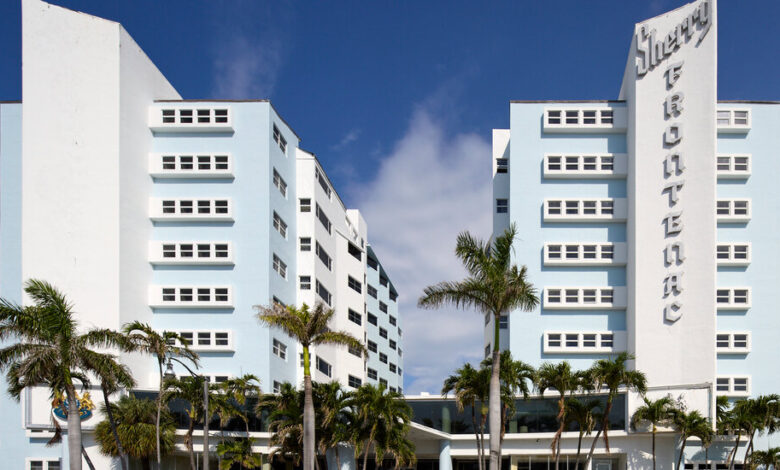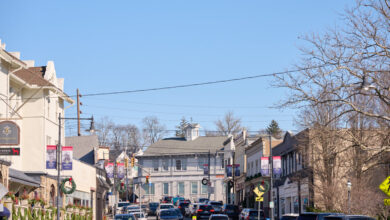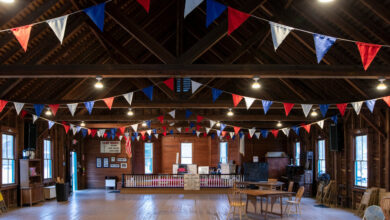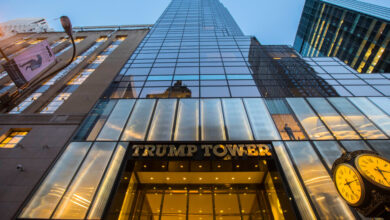A New Law Would Remove Many Architectural Protections in Miami Beach

[ad_1]
The oceanfront Eden Roc Hotel is an icon of Miami Modernist architecture, a style that epitomized the postwar glamour and grandeur of Miami Beach. Two turquoise panels wrap the white facade. The oval canister perched atop the building resembles a cruise ship’s funnel. Crooners like Frank Sinatra, Harry Belafonte, and Sammy Davis, Jr., stayed and played there.
But a new Florida law could make it easier for hotels like the Eden Roc and other architectural icons along Miami Beach’s coastline to be demolished.
The battle pits the pressures of development and climate change against the benefits of historical preservation, in a city that has long paved over its past and prizes the new, shiny, and glitzy.
Supporters say the law addresses environmental and safety challenges of aging properties after the deadly 2021 collapse of the Champlain Towers South condo. But critics believe the legislation is a pretext to facilitate the demolition of historical buildings — ones that give Miami Beach its distinct look — to make way for high-rise luxury condos.
The new law effectively strips Miami Beach Historic Preservation Board of its long-held power to say whether historic structures can be demolished and, if a structure is knocked down, to ensure that at least some elements of its design are preserved or replicated.
“Let’s just bulldoze the past — that’s their idea,” said Daniel Ciraldo, the executive director of the nonprofit Miami Design Preservation League. “I don’t think we’ve seen such an attack on our local controls since the 1980s, back when the city first started to do historic preservation.”
The legislation, signed last week by Gov. Ron DeSantis, is known as the Resiliency and Safe Structures Act, had been passed easily by both houses of the Republican-controlled Florida Legislature by a 36 to 2 vote in the Senate and an 86 to 29 vote in the House.
It allows owners to demolish buildings in high-risk coastal flood zones if local officials deem the structures unsafe, if the local government has jurisdiction, or if the buildings don’t conform to the base flood elevation requirements set by the Federal Emergency Management Agency (FEMA). Preservationists warn that few, if any, historical buildings meet the federal agency’s current standards.
The law targets oceanfront buildings along the so-called coastal construction control line, a border created to delineate how close developers can build to the coast. In Miami Beach, the endangered properties are concentrated among the Miami Modernist, or MiMo-style resorts along Collins Avenue in the Mid Beach and North Beach neighborhoods, such as the Faena, Casablanca, Carillon, Sherry Frontenac, Edition hotels, as well as a handful of Art Deco buildings in the South-of-Fifth neighborhood, such as the Savoy Hotel.
As sea levels continue to rise around Florida and hurricanes grow strong and frequent, legislators believe local preservation boards have grown too powerful to the detriment of property owners, making a change in the law necessary.
“Boards have weaponized this process,” said Spencer Roach, a state representative who cosponsored the bill, during a committee hearing last month.
Representative Roach said the preservation boards were requiring owners to build their properties back to the original specifications. “It renders them prohibitively expensive to insure and guarantees that these buildings will be demolished again the next time a storm comes along,” added the lawmaker, who represents North Fort Myers, which was hit hard by Hurricane Ian in 2022.
Buildings erected replace historic structures would be subject to regular zoning laws, making input from preservation boards obsolete.
After a 2017 electrical fire at the Deauville — a MiMo resort, where The Beatles performed on the “Ed Sullivan Show” in 1964 — the Miami Beach government sued the owners, the Meruelo family, to compel renovations. The Meruelos said they didn’t have the funds. By 2022, months after the Champlain condo collapse, the hotel had fallen into such disrepair that a local building official deemed it unsafe and ordered it to be demolished. The Miami Design Preservation League appealed the building official’s demolition order to the Miami-Dade Board of Rules and Appeals, but a Miami judge upheld the order, and the building came down in 2022.
Preservationists fear that the new legislation will incentivize other owners to follow suit.
Architecture helped put Miami Beach on the map as a global destination. Colorful, sleek Art Deco represented a lifeline for the city during the Great Depression. Despite the hard times, some developers still saw an opportunity in Miami Beach hospitality, thanks to the town’s reputation for freewheeling hedonism that reigned during Prohibition. With their limited resources, the developers built short, two to three-story hotels, opting for the trendy urban aesthetic at the time, which was Art Deco.
After a lull in construction during World War II, the next architectural style that swept Miami was homegrown: Miami Modernism. Inspired by the boxy, white structures of European modernist architecture and the retrofuturist aesthetic of midcentury design, MiMo embodied the postwar economic boom of the 1950s and 1960s. The architect Morris Lapidus led the charge, drawing up wide and tall resorts, such as the now iconic Fontainebleau and Eden Roc that attracted the Hollywood stars.
But in the late 1970s, Miami Beach faced financial woes and developers threatened to tear down old properties. Activists, led by Barbara Baer Capitman, saw the historic preservation of the Art Deco and later MiMo buildings as a way of reviving the city. The renewed attention helped attract artists and designers, such as Gianni Versace, who rebranded the seedy beach town as a cosmopolitan party destination.
Had preservationists lost, “Miami Beach would be no different than any other beach resort,” said Robin F. Bachin, a history professor at the University of Miami.
Neither Representative Roach nor his co-sponsor on the bill, Bryan Avila, a Florida state senator, responded to several requests for comment by telephone and email.
This was the second time legislators tried to pass a law. The initial effort failed last year after strong opposition from some local officials and preservationists. This time around, the law exempts St. Augustine, Palm Beach, Key West, and the famed section of the Ocean Drive promenade in Miami Beach, which is lined with pastel-colored Art Deco buildings, as well as individual buildings such as the Fontainebleau Hotel.
In recent years, Miami Beach residents have pushed back on development. In November, Miami Beach voters elected a new mayor who vowed to “stop overdevelopment.” In 2022 referendums, Miami Beach voters rejected two proposals to redevelop city-owned properties into office and mixed-use developments, as well as the replacement project for the Deauville hotel that was designed by the architect Frank Gehry.
The pull and tug between construction and conservation is nothing new for Miami Beach, a town long powered by showmanship and real estate speculators. “It was capitalism that created South Beach in the ’30s,” said Keith D. Revell, a professor of public administration at Florida International University, whose research focuses on the redevelopment of South Beach.
And then “the preservation movement came along and said ‘This is not just real estate. They’re historic, valuable — we need to acknowledge that.’”
[ad_2]
Source link






